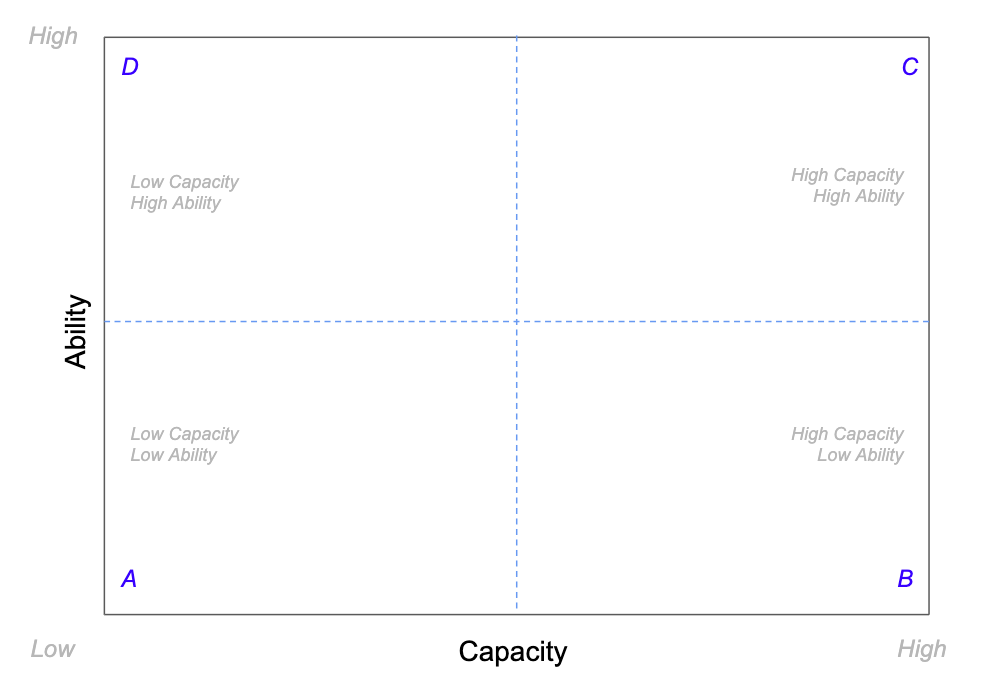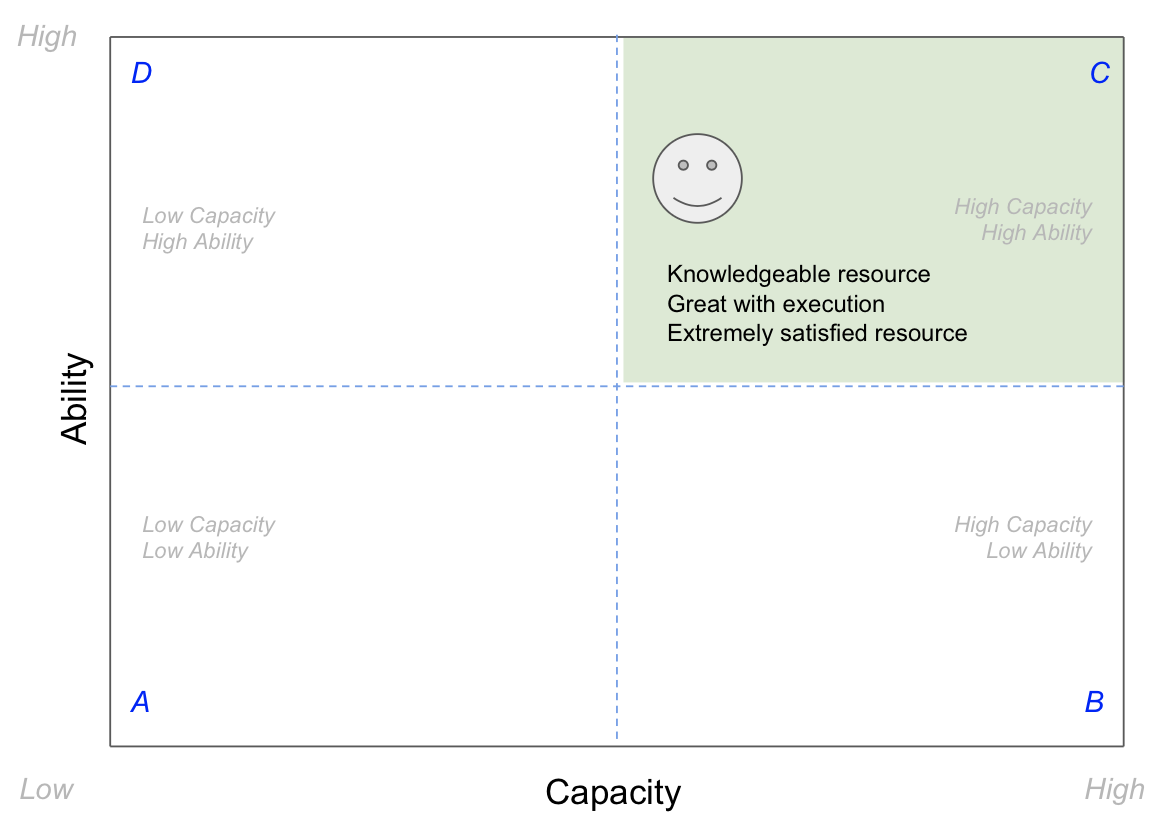I have a keen interest in Design Ops and as I get more involved in Leadership roles, I am always conscious about the utilisation of my resources. As the Design team grows and Design systems comes in place, there is always the danger of not properly utilising the resources. And when it comes to working with designers, there is always the tricky bit of managing what one wants to do versus what is asked to do. In my opinion, managing designers is different than managing other resources due to the strong associations with personal biases that designers bring to the work.
Earlier there was no systematic way for me to understand this for each of the resources. In a course by Azim Premji University, that I attended a few months ago, the facilitator introduced us to the concept of the Capability Matrix. I found it extremely helpful to analyse my own self and these days, I use this for better managing my teams and also to predict the movement of resources in and out of the organisation.

The word Capability can be looked as being derived from “Capacity + Ability”. These comprise the two axes of the Capability Matrix.
Capacity being defined by ‘how much’ the resource knows. One can gauge this from the work experience and the education background of the resource. I often try to understand this by understanding the thought process behind the work, the execution of the work and the discussions in the critique sessions thereafter. Building capacity is an ongoing process, and any person possessing a learning attitude does this regularly over a period of time. The ways to increase capacity include taking up challenging work from time to time, seeking critical feedback of the work, going out of the comfort zone to learn new things, attend conferences, take up courses / master classes regularly.
Ability being defined by ‘how well’ the resource is able to apply the acquired knowledge in the context of work. The ability thus is to understand how well the resource is able to perform the task as per their capacity, in the execution of a certain work and in a stipulated amount of time. Over time, as one picks up different skills and execution prowess, the ability evolves. Ability is a function of time, and it increases over the years. One’s ability to take up and deliver work also increases over the years.
A resources’ utilisation is can be looked as a function of Capacity / Ability and as a design leader, one is constantly thinking about the utilisation of their resources.
Needless to say, the ideal resource for any leader is one who has high capacity and high ability. Discontent within the resources arise when they are in different quadrants than they expect themselves to be. This could be due to the circumstances that the team finds itself in due to organisation priorities, and the availability of resources to take up projects. Often when the team is understaffed, there is a discontent as the present resources to not feel fully utilised.
As a design leader one has to be cognisant about this and manage the resource accordingly. This Capability Matrix comes handy in analysing a few scenarios that a designer leader may face. As designers grow in their roles, they move from being individual contributors on creating mockups to desiring to be involved in the strategy and product road-mapping as well. As a design leader it is imperative to find these opportunities and map resources accordingly.
In a typical technology product company, where the designer works closely with the product and engineering folks, there are multiple things that can fill up the designer’s time. From understanding the requirements to participating in ceremonies (stand-ups to retros, grooming sessions to quality evaluation session) to actually doing tasks. As a design leader one would need to ensure that the resource’s time is utilised well.
Quadrant A is the quadrant of Low Capacity and Low Ability

Folks who fall in quadrant A would typically be interns, or freshers, or junior employees who have just got started and do not have in depth knowledge about the domain they are working in. Over a period of time the resource would move from this quadrant to other quadrants. It is also a go-to quadrant in case you want to start afresh. Resources in this quadrant would take more time to get tasks done. As a design leader it is one’s responsibility to constantly find opportunities for the capacity and ability growth of the resource. Mapping out a time frame to the development of the resource is important. This quadrant could also be resources who are not performing well or are under utilising their ability due to the paucity of capacity. A resource in this state is expected to constantly put in the efforts to build their capacity.
Quadrant B is the quadrant of High Capacity and Low Ability

Folks who fall in this state would be the ones who are very experienced, have spent a lot of time in the industry and picked up a lot of information / knowledge, but are not getting the right opportunity to apply these learnings in the context of the work. Often the low ability means that the person would end up getting frustrated for not performing up to their ability. In the one-on-ones we expect this resource to be always talking about work that they want to do or the things they have done in the past. As a design leader one is expected to check on this and provide the right challenging work for the resource to be able to put their capacity to good use. This can be achieved by providing challenging work that allows the resource to use their capacity well. Having the resource take on new initiatives that are based on their capacity and previous knowledge is also a good way to enhance their ability to contribute.
Quadrant C is High Capability / High Ability

This is the quadrant of maximum work satisfaction and ideally where everyone wants to aim towards. The designer is performing as per his/her ability and his/her capacity is utilised well. As a design leader, this is where you want all your reportees to be. A leader one should be spending sufficient time in trying to achieve this within the team. Once achieved it becomes important to sustain it for a longer period of time to enhance team dynamics. Having the resource continuously share their work with the larger team works best in ensuring that this state of the resources continue and others in the team gets inspired. As a leader it is key to continuously communicate with the resource, for this state can be very short lived.
Quadrant D is Low Capacity and High Ability

In this state one can be expected to utilise less on the personal capacity, but get work done really well. The end goal here for resources here is to get the work done in the stipulated time and the focus is on delivery. In a world where a lot of the thinking part of the solution finding is taken care by the product teams, and the designers are relegated to creating mockups and screens only, the pressure becomes to deliver within the sprint time. Often this reduces the explorations and iterations of the design solutions. Resources in this quadrant are great at following instructions, and have developed the ability to execute as per the requirements listed in the product requirements document (PRDs). This is the quadrant where you have maximum burn outs, for the person is really being stretched to do multiple tasks, and perform to the best of their ability.
Low Utilisation as a cause for high attrition
As a (design) leader, attrition is something one needs to take seriously. While there are multiple factors that causes high attrition, low utilisation is also a major reason why resources leave. Utilisation for a resource can be directly proportional to the value add that they bring to the project / team. Every individual has different things to contribute, and as a leader one needs to identify it and provide the means to make it happen.
In design worldwide, where there are too many opportunities for the designer, there is always a risk of high attrition that a team faces. As a design leader it is one’s responsibility to ensure that the utilisation of the resource is optimum. One wants to provide the right opportunities for this to happen. In the ideal scenario, we would want all of us to be in the quadrant C; i.e. the one where we feel that we are being able to perform / work as per our capacity and ability, i.e. best to one’s capability.
Resources move from one quadrant to the other on a regular basis. Here are some scenarios that I have put across. There could be more and with different reasons too.

A –> B : A resource deciding to take some time to build further capacity by reading, attending courses, attending master classes etc.
A –> D : A resources wanting to focus on executing more work with the capacity their possess. Often this results in the the resource moving to a faster paced work environment
D –> A : A resource deciding to take a more relaxed approach to work. Knowing that their capacity is not going to be used, nor there is the pressure of delivery.
C –> B : A resource in the industry deciding to take a break and teach by contributing their knowledge to teach students.
C –> D : A resource wanting to experience a more fast paced culture (often at a startup), or in lieu of higher compensations.
B –> C : Ideally resources wanting to do this, but often not possible, due to having to starting anew after the new capacity has been built.A possible path could be B — > A — > C
In conclusion
Over the years, as I built teams and organisations, this are somethings I am conscious about and always try to evaluate my resources through this. It allows me to gauge their involvement and their satisfaction of working with me / my organisation. I would love to know more from you on how you manage teams within your organisation.
#DesignOps #DesignOperations #TeamBuilding
